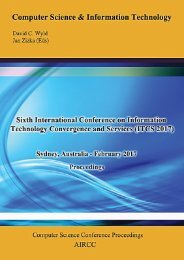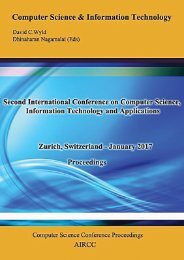CoSIT 2017
Fourth International Conference on Computer Science and Information Technology ( CoSIT 2017 ), Geneva, Switzerland - March 2017
Fourth International Conference on Computer Science and Information Technology ( CoSIT 2017 ), Geneva, Switzerland - March 2017
You also want an ePaper? Increase the reach of your titles
YUMPU automatically turns print PDFs into web optimized ePapers that Google loves.
18 Computer Science & Information Technology (CS & IT)<br />
2. DECISION TABLES<br />
The Decision Table is an auxiliary tool in describing procedures for solving complex problems<br />
[9]. A Conventional Decision Table, presented in Table 1, can be considered as a problem<br />
composed of conditions, actions and rules where conditions are variables that must be evaluated<br />
for decision making, actions are the set of operations to be performed depending on the<br />
conditions at this moment, and the rules are the set of situations that are verified in response to the<br />
conditions .<br />
. Table 1. Conventional Decision Tables.<br />
Conditions rows<br />
Actions rows<br />
Rules column<br />
Condition values<br />
Actions to be taken<br />
A rule is constituted by the association of conditions and actions in a given column. The set of<br />
rule columns should cover all possibilities that may occur depending on the observed conditions<br />
and the actions to be taken. Depending on the current conditions of a problem, we look for which<br />
table rules satisfy these conditions:<br />
• If no rule satisfies the conditions imposed, no action is taken;<br />
• If only one rule applies, then the actions corresponding to the rule are executed;<br />
• If more than one rule satisfies the conditions, then the actions corresponding to the rules are<br />
applied in parallel.<br />
• Once the rules are applied, the table can be used again.<br />
• The rules of a decision table are pre-defined and new rules can only be added or deleted by<br />
reviewing the table.<br />
2.1. Adaptive Decision Tables<br />
In 2001 Neto introduces the Adaptive Decision Table (ADT) [7] from a rule-driven adaptive<br />
device. In addition to rule lookup, an ADT allows you to include or exclude a rule from the rule<br />
set during device operation. As an example of its potential, Neto simulates an adaptive automaton<br />
to recognize sentences from context-dependent languages. In the ADT a conventional decision<br />
table is the underlying device to which a set of lines will be added to define the adaptive<br />
functions.<br />
Adaptive functions constitute the adaptive layer of the adaptive device governed by rules.<br />
Modifying the rule set implies increasing the number of columns in the case of rule insertion, or<br />
decreasing the number of columns in the case of rule deletion. In both cases the amount of lines<br />
remains fixed. The Adaptive Decision Table (ADT) is capable to change its set of rules as a<br />
response to an external stimulus through the action of adaptive functions [7]. However, the<br />
implementation of more complex actions is not a simple task due to the limitation of the three<br />
elementary operations supported by ADT [9].<br />
When a typical adaptive device is in operation and does not find applicable rules, it stops<br />
executing, indicating that this situation was not foreseen. For continuous operation devices, which<br />
do not have accepting or rejecting terminal states, stopping their execution would recognize an<br />
unforeseen situation and constitutes an error.





